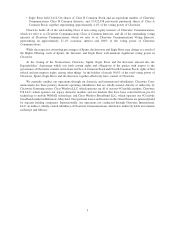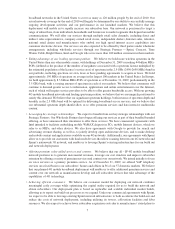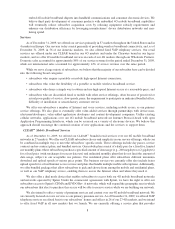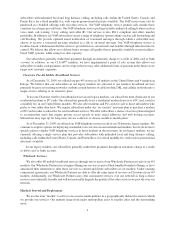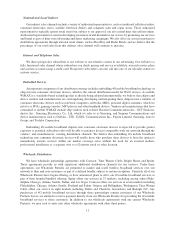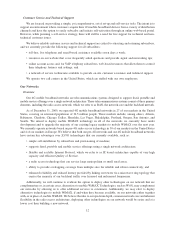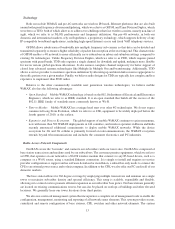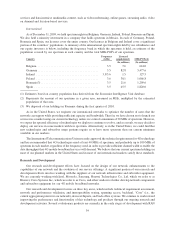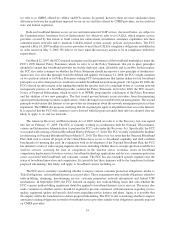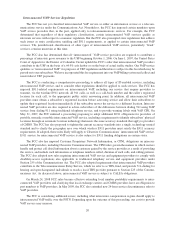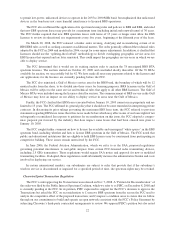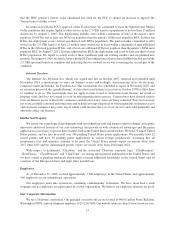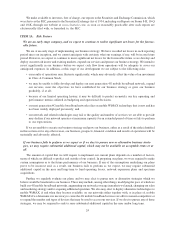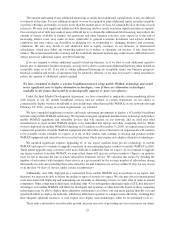Clearwire 2009 Annual Report Download - page 25
Download and view the complete annual report
Please find page 25 of the 2009 Clearwire annual report below. You can navigate through the pages in the report by either clicking on the pages listed below, or by using the keyword search tool below to find specific information within the annual report.li
cense
df
requenc
i
es
i
nover
l
app
i
ng geograp
hi
c areas, ma
ki
ng qua
li
ty an
d
ava
il
a
bili
ty o
f
t
h
e
i
r serv
i
ce
s
un
p
redictable
.
We are designing our network in the United States to operate primarily on spectrum located within the 249
6
t
o
2690 MHz band, commonl
y
referred to as the 2.
5
GHz band, which is desi
g
nated for Broadband Radio Service
,
which we refer to as BRS, and Educational Broadband Service, which we refer to as EBS. Most BRS and EB
S
li
censes are a
ll
ocate
d
to spec
ifi
c Geograp
hi
c Serv
i
ce Areas. Ot
h
er BRS
li
censes prov
id
e
f
or 493 separate Bas
ic
Tradin
g
Areas, which we refer to as BTA. Under current FCC rules, the BRS and EBS band in each territor
y
is
g
enerall
y
divided into 33 channels consistin
g
of a total of 186 MHz of spectrum, with an additional ei
g
ht MHz o
f
guar
db
an
d
spectrum, w
hi
c
hf
urt
h
er protects aga
i
nst
i
nter
f
erence
f
rom ot
h
er
li
cense
h
o
ld
ers. Un
d
er current FCC
r
ules, we can access BRS spectrum either throu
g
h outri
g
ht ownership of a BRS license issued b
y
the FCC or throu
gh
a leasin
g
arran
g
ement with a BRS license holder. The FCC rules
g
enerall
y
limit eli
g
ibilit
y
to hold EBS licenses t
o
accre
di
te
d
e
d
ucat
i
ona
li
nst
i
tut
i
ons an
d
certa
i
n governmenta
l
,re
li
g
i
ous an
d
nonpro
fi
t ent
i
t
i
es,
b
ut perm
i
tt
h
os
e
license holders to lease up to 95% of their capacit
y
for non-educational purposes. Therefore, apart from a few EBS
li
censes we acqu
i
re
d
un
d
er an o
ld
EBS ru
l
e, we access EBS spectrum t
h
rou
gh l
on
g
-term
l
eas
i
n
g
arran
g
ements w
i
t
h
EBS license holders. EBS leases entered into before January 10, 200
5
may remain in effect for up to 1
5
years an
d
m
a
yb
e renewe
d
an
d
ass
ig
ne
di
n accor
d
ance w
i
t
h
t
h
e terms o
f
t
h
ose
l
eases an
d
t
h
e app
li
ca
bl
e FCC ru
l
es an
d
r
e
g
ulations. The initial term of EBS leases entered into after Januar
y
10, 2005 is required b
y
FCC rules to be
c
oterminous with the term of the license. In addition, these leases t
y
picall
yg
ive the leaseholder the ri
g
ht t
o
p
art
i
c
i
pate
i
nan
d
mon
i
tor comp
li
ance
b
yt
h
e
li
cense
h
o
ld
er w
i
t
h
FCC ru
l
es an
d
regu
l
at
i
ons. EBS
l
eases entere
di
nt
o
after Jul
y
19, 2006 that exceed 15
y
ears in len
g
th must
g
ive the licensee the ri
g
ht to reassess their educational use
r
equirements ever
y
five
y
ears startin
g
in
y
ear 1
5
. Our EBS spectrum leases t
y
picall
y
have an initial term equal to th
e
r
ema
i
n
i
ng term o
f
t
h
e EBS
li
cense, w
i
t
h
an opt
i
on to renew t
h
e
l
ease
f
or a
ddi
t
i
ona
l
terms,
f
or a tota
ll
ease term o
f
u
p
t
o30
y
ears. In addition, we
g
enerall
y
have a ri
g
ht of first refusal for a period of time after our leases expire o
r
otherwise terminate to match another part
y
’s offer to lease the same spectrum. Our leases are
g
enerall
y
transferable.
We
h
ave BRS
li
censes an
dl
eases, as we
ll
as EBS
l
eases,
i
na
l
ar
g
e num
b
er o
f
mar
k
ets across t
h
eUn
i
te
d
States.
W
e believe that our si
g
nificant spectrum holdin
g
s, both in terms of spectrum depth and breadth, in the 2.
5
GHz band
will be optimal for deliverin
g
our 4G mobile broadband services. As of December 31, 2009, we believe we were the
l
argest
h
o
ld
er o
fli
cense
d
w
i
re
l
ess spectrum
i
nt
h
eUn
i
te
d
States. As o
f
Decem
b
er 31, 2009, we owne
d
or
l
ease
d
,o
r
had entered into a
g
reements to acquire or lease, over 44 billion MHz-POPs of spectrum in the United States. Of this
over 44 billion MHz-POPs of spectrum in the United States, we estimate that we own approximatel
y
41% of those
MHz-POPs w
i
t
h
t
h
e rema
i
n
d
er
b
e
i
ng
l
ease
df
rom t
hi
r
d
part
i
es, genera
ll
yun
d
er
l
ease terms t
h
at exten
d
up t
o
3
0
y
ears. As of December 31, 2009, the wei
g
hted avera
g
e remainin
g
life of these spectrum leases based on the valu
e
of all payments that we are amortizing over the life of the spectrum leases was approximately 26 years, including
r
ene
w
a
l
terms.
Our pendin
g
spectrum acquisition and lease a
g
reements are sub
j
ect to various closin
g
conditions, some of
w
hi
c
h
are outs
id
eo
f
our contro
l
an
d
, as a resu
l
t, we may not acqu
i
re or
l
ease a
ll
o
f
t
h
e spectrum t
h
at
i
ssu
bj
ect t
o
th
ese agreements. Near
l
ya
ll
o
f
suc
h
c
l
os
i
ng con
di
t
i
ons re
l
ate e
i
t
h
er to
li
censee or FCC consents, w
hi
c
h
we expec
t
are likel
y
to be
g
ranted. A limited number of our pendin
g
acquisition a
g
reements are sub
j
ect to closin
g
condition
s
i
nvo
l
v
i
ng t
h
e reso
l
ut
i
on o
fb
an
k
ruptcy or s
i
m
il
ar procee
di
ngs. As o
f
Decem
b
er 31, 2009, we
h
a
d
m
i
n
i
mu
m
p
urchase commitments of approximatel
y
$30.0 million to acquire new spectrum.
We engineer our networks to optimize both the service that we offer and the number of subscribers to whom w
e
c
an o
ff
er serv
i
ce. Upon t
h
ec
h
ange to 4G mo
bil
e
b
roa
db
an
d
tec
h
no
l
ogy, we genera
ll
y
d
o not expect to
l
aunc
h
ou
r
s
ervices in a market unless we control, throu
g
h license or lease, a minimum of three conti
g
uous blocks of 10 MHz of
s
pectrum bandwidth. However, we expect the spectral efficienc
y
of technolo
g
ies we deplo
y
to continue to evolve
,
an
d
as a resu
l
t, we may
d
ec
id
eto
d
ep
l
oy our serv
i
ces
i
n some mar
k
ets w
i
t
hl
ess spectrum. A
l
ternat
i
ve
l
y, we ma
y
find that new technolo
g
ies and subscriber usa
g
e patterns make it necessar
y
or practical for us to have more spectru
m
ava
il
a
bl
e
i
n our mar
k
ets pr
i
or to
l
aunc
hi
ng our serv
i
ces
i
nt
h
at mar
k
et.
We
h
o
ld
approx
i
mate
ly
120 MHz o
f
spectrum on avera
g
e across our nat
i
ona
l
spectrum
f
ootpr
i
nt. Our
d
eep
sp
ectrum
p
osition in most of our markets is ex
p
ected to enable us to offer faster download s
p
eeds and
p
remium
15


